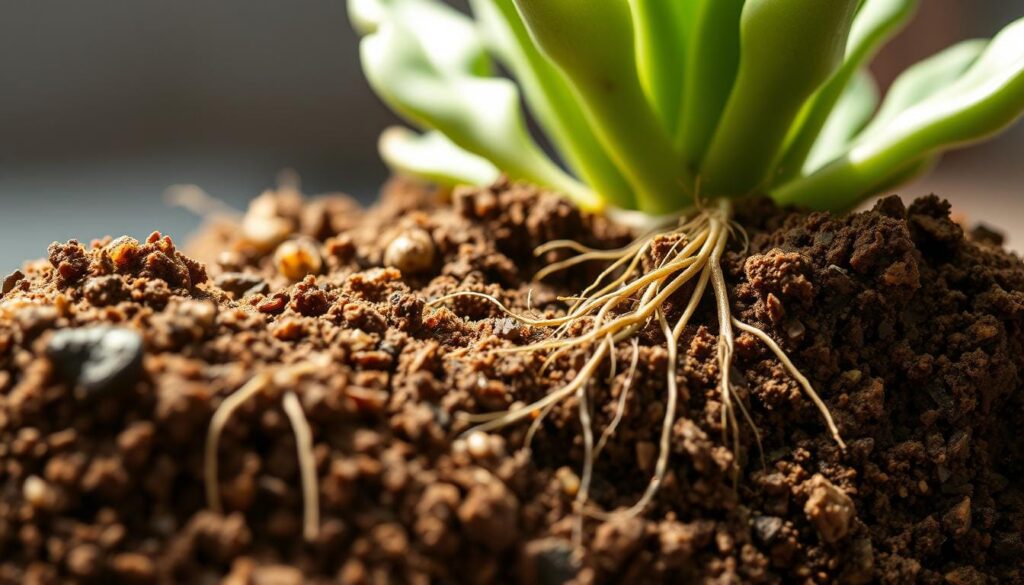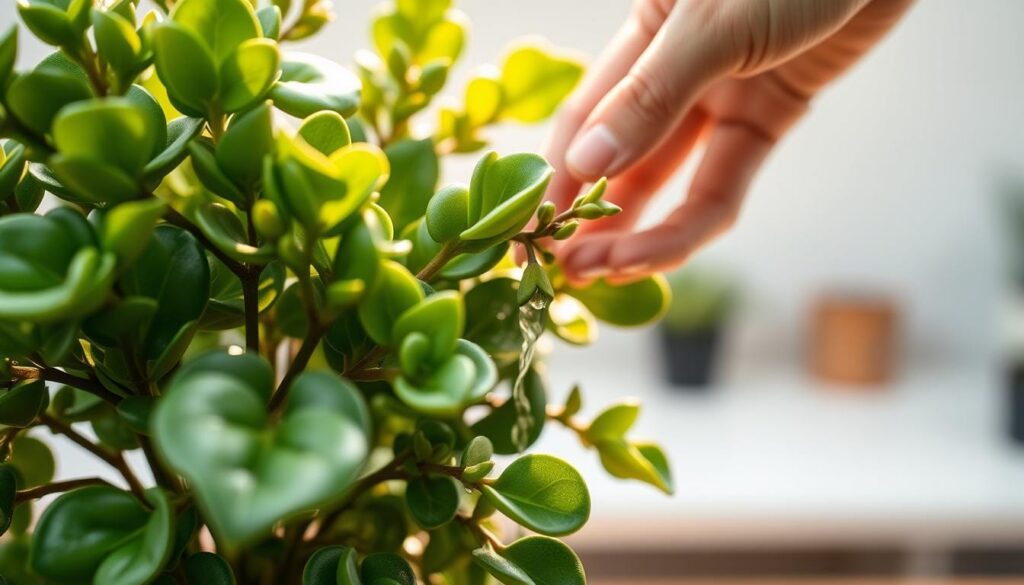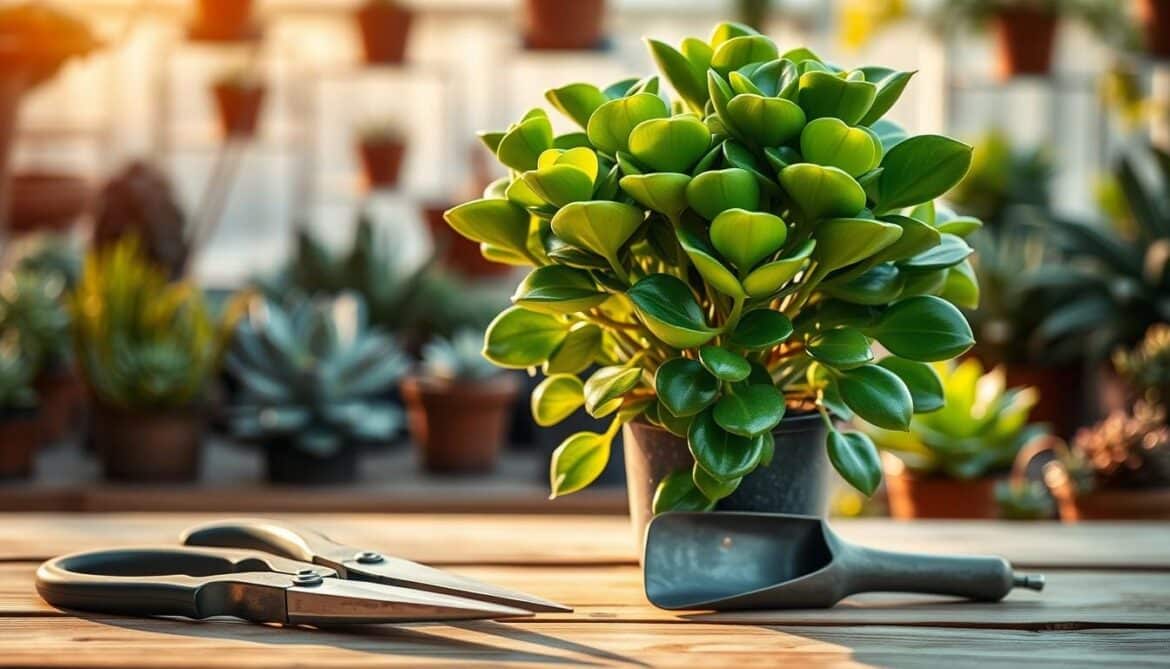Growing up, I remember my grandmother’s jade plant in her sunroom. It was a green companion that seemed almost indestructible. I didn’t know then about the delicate balance of jade plant care and the diseases that could threaten these beautiful succulents.
Jade plants (Crassula ovata) have been loved in the Americas for over 100 years. They are cherished for their striking appearance and ease of maintenance. Despite their hardiness, these plants can get sick from various jade plant diseases that harm their health and vitality.
Knowing how to care for jade plants is key to preventing and managing health issues. These plants need careful care and the right environment to thrive. Issues like root rot and pest infestations can happen if they don’t get what they need.
Key Takeaways
- Jade plants are susceptible to various diseases, mainly from bad care
- Overwatering is the top cause of jade plant health problems
- Spotting symptoms early is vital for the plant’s survival
- Good drainage and soil are essential for healthy growth
- Regular care can stop most jade plant diseases
Overview of Jade Plant Diseases
Jade plants are popular houseplants known for their toughness. But, they can face health problems that need quick attention and good care.
It’s important to know about jade plant diseases to keep your plant healthy. These plants can get sick in many ways, affecting their growth and look.
Common Issues Affecting Jade Plants
Jade plants can have several health problems:
- Fungal infections like powdery mildew
- Pest infestations, like mealybugs
- Root rot from too much water
- Bacterial soft rot
- Environmental stress
Importance of Early Disease Detection
Finding problems early can save your jade plant. Quickly spotting and fixing issues is vital to avoid long-term damage.
| Disease Type | Primary Symptoms | Potential Impact |
|---|---|---|
| Fungal Infections | White powder, dark lesions | Leaf damage, stunted growth |
| Pest Infestations | White cotton-like clusters | Deformed new growth |
| Root Rot | Yellowing leaves, soft stems | Potential plant death |
To care for your jade plant, understand these diseases and take steps to prevent them. Regular checks, proper watering, and the right growing conditions are key to a healthy jade plant.
Identifying Symptoms of Jade Plant Diseases
It’s important to spot disease signs early to keep your jade plant healthy. Jade plants can show signs of disease in different ways. Knowing these signs helps prevent serious damage and keeps your plant alive.
Leaf spots and other changes can show that something is wrong. These signs point to specific problems that need quick action.
Wilting Leaves: Causes and Solutions
Jade plants wilt for a few main reasons:
- Improper watering techniques
- Root system damage
- Temperature stress
- Nutrient deficiencies
When leaves start to droop, it means the plant is stressed. Checking the soil and roots is key.
Yellowing Leaves and Drop: What It Means
Yellow leaves on jade plants are a big warning. Up to 40% of leaf health can be lost due to problems.
| Symptom | Potential Cause | Action Required |
|---|---|---|
| Uniform Yellow Leaves | Overwatering | Reduce watering frequency |
| Yellowing with Brown Spots | Fungal Infection | Treat with fungicide |
| Bottom Leaf Yellowing | Natural Aging | Remove dead leaves |
The Role of Fungal Infections in Symptoms
Fungal infections can harm jade plants a lot. Early signs are small whitish spots on leaves. These spots spread fast in moist conditions. Preventing excess moisture stops fungal growth.
With the right care and quick action, most jade plant diseases can be managed. This keeps your plant healthy and lively.
Root Rot in Jade Plants
Jade plant root rot is a serious problem that can harm your favorite succulent. It’s important to know the causes, symptoms, and how to prevent it. This helps keep your jade plant healthy.
Root rot happens when jade plants get too much water and don’t drain well. Too much water lets fungi and bacteria grow. These harmful organisms attack the plant’s roots.
Primary Causes of Root Rot
- Excessive watering (90% of cases)
- Poor soil drainage
- Inadequate pot drainage
- Compacted soil preventing air circulation
Recognizing Root Rot Symptoms
Spotting root rot early is key to saving your jade plant. Look out for these signs:
- Yellowing leaves (70% of affected plants)
- Wilting or stunted growth (60% occurrence)
- Foul odors from soil (50% of cases)
- Dark, mushy roots
Prevention Strategies for Jade Plant Care
To keep your plant safe, follow these important steps:
| Prevention Method | Effectiveness |
|---|---|
| Use well-draining soil mix | 40% improved drainage |
| Water only when soil is dry | 65% reduced root rot risk |
| Ensure pot has drainage holes | 85% prevention of moisture retention |
| Regular plant inspections | 70% early problem detection |
By knowing about jade plant root rot and using the right care, you can keep your succulent safe. This ensures it stays healthy for a long time.
Pest Infestations Affecting Jade Plants
Jade plants face threats from many pests. These pests can harm their health and look. Knowing about these pests is key to keeping your plant safe.
Some insects are more harmful to jade plants than others. The most common pests include:
- Mealybugs
- Spider mites
- Scale insects
- Aphids
- Thrips
Common Pest Characteristics
Each pest has its own challenges. Mealybugs, for example, look like white, fluffy stuff on plants. They can really hurt plants if not treated.
| Pest | Visible Signs | Potential Damage |
|---|---|---|
| Mealybugs | White cottony clusters | Sap extraction, plant weakening |
| Spider Mites | Fine webbing, stippled leaves | Leaf discoloration, stunted growth |
| Scale Insects | Small brown bumps | Leaf yellowing, reduced vigor |
Identifying Signs of Pest Damage
Spotting pests early is very important. Look out for these signs:
- Discolored or spotted leaves
- Sticky residue on plant surfaces
- Visible insects or webs
- Stunted growth
Natural Remedies for Pest Control
There are natural ways to fight pests:
- Isopropyl alcohol: Kills pests without harming plants
- Neem oil treatments
- Strong water sprays to get rid of insects
- Introducing beneficial insects
Regular checks and quick action help keep jade plants healthy. This stops pests from taking over.
Fungal Infections and Their Impact
Jade plant fungus can be a big problem for plant lovers. Fungal infections can harm your succulent a lot if not treated. It’s important to know the signs and how to treat them to keep your plant healthy.
Powdery mildew is a common fungal issue for jade plants. It often happens in places with:
- High humidity
- Poor air circulation
- Low light conditions
- Temperatures below optimal range
Recognizing Fungal Infection Symptoms
Spotting jade plant fungus early is key. Watch for these signs:
- White powdery coating on leaves and stems
- Patchy spots resembling dust
- Discoloration of plant tissues
- Leaf distortion or wilting
Effective Treatment Options
Several methods can help treat jade plant fungus:
- Improve air circulation around the plant
- Reduce humidity levels
- Use fungicidal treatments
- Prune infected areas carefully
A mix of baking soda, mild soap, and water can be a good organic treatment. For serious cases, you might need systemic fungicides like Phyton-27. Always check the diagnosis before treating.
Prevention is always better than cure when managing fungal infections in jade plants.
Bacterial Diseases in Jade Plants
Jade plants can get sick from various bacterial diseases. These infections can harm your plant quickly. It’s important to know how to care for your plant to keep it healthy.
There are several signs of bacterial diseases in jade plants. Look out for:
- Soft, mushy stem tissues
- Dark, water-soaked lesions
- Sudden leaf collapse
- Foul-smelling plant tissues
Identifying Critical Bacterial Infections
Bacterial soft rot is a serious disease. It makes stems and branches fall apart. Quick action is needed to save your plant.
Treatment Strategies for Bacterial Infections
To treat bacterial infections, follow these steps:
- Isolate the infected plant right away
- Remove any parts that look sick
- Use clean cutting tools
- Apply copper-based bactericides
- Throw away plants that are too sick to save
To avoid bacterial diseases, keep your plant clean. Don’t overwater and make sure it has enough air. This helps prevent infections.
Sunburn and Environmental Stress
Jade plant care needs careful attention to the environment. This is key to protect these succulents from sunburn and temperature changes. Knowing how light and heat affect your jade plant is vital for its health and look.
Identifying Sunburn in Jade Plants
Sunburn is a big problem in jade plant care. It can harm your plant’s leaves. Jade plants show signs of stress when they get too much direct sunlight:
- Discolored or brownish patches on leaves
- Crispy, dried-out leaf edges
- Leaves that appear bleached or washed out
Impact of Temperature Changes
Jade plants don’t like extreme temperature changes. They do best in temperatures between 60-70°F. A little cooler at night is good. But sudden changes can stress the plant and harm its growth.
To avoid sunburn and temperature stress in jade plant care, try these tips:
- Gradually get plants used to new light
- Use sheer curtains to soften afternoon sun
- Rotate plants to get even light
- Keep them away from cold drafts and sudden temperature drops
Pro tip: Indoor jade plants are more likely to get sunburn because they’re used to weaker indoor light.
Proper jade plant care means knowing their environmental needs. Create a stable, caring environment that’s like their natural home. By watching light and temperature, you can help your jade plant stay healthy and look great.
Watering Issues and Their Consequences
Jade plant care needs a careful touch when it comes to watering. These plants are very sensitive to water levels. Too much water is a bigger problem than too little. Knowing what your jade plant needs can stop it from wilting and other health problems.
Managing water is key to a jade plant’s health. The idea of “wet feet” is harmful. Too much moisture can cause root rot and other serious issues.
Symptoms of Improper Watering
- Overwatering signs:
- Yellowing leaves
- Soft, mushy stems
- Potential root rot development
- Underwatering indicators:
- Shriveled, wrinkled leaves
- Stunted growth
- Dry, crispy leaf edges
Proper Watering Techniques
To avoid jade plant wilting, follow these important watering tips:
- Let the topsoil dry out completely before watering again
- Use soil that drains well
- Water less during the plant’s dormant winter months
- Make sure pots have holes for drainage
Successful jade plant care means knowing its special water needs. The goal is to give it water like it would get in the desert. This means giving it water carefully and at the right times.
Soil Quality and Its Effect on Health
Jade plant care starts with knowing how important soil quality is. The right soil can make a big difference. It can turn a struggling jade plant into a thriving one.

To treat jade plants right, you need the perfect soil. Experts say to use a special soil mix. It should drain well and support nutrients.
Understanding Soil Composition
The best soil for jade plants has a mix of:
- 2 parts houseplant or succulent soil
- 2 parts coarse sand
- 1 part perlite or pumice
Drainage: The Key to Healthy Roots
Drainage is key for jade plant health. Roots in wet soil are at risk of bacterial infections and root rot. The soil’s pH should be between 6 to 7, slightly acidic to neutral.
Selecting the Right Container
Choosing the right pot is important for jade plant care. Clay and terracotta pots are best because they:
- Let excess moisture escape
- Stop water from staying
- Help roots stay healthy
By focusing on soil quality and drainage, you’ll give your jade plant the best chance to thrive. This prevents problems like root rot and nutrient shortages.
Seasonal Changes and Plant Health
Jade plant care needs attention to seasonal changes. These plants change a lot through the year. Knowing these changes helps keep your jade plant healthy and disease-free.
Seasonal growth patterns affect how you care for jade plants. They need different care in growing seasons than in dormant ones.
How Seasonal Changes Impact Jade Plant Growth
Jade plants grow differently with the seasons. Here are the main seasonal traits:
- Spring/Summer (Growing Season):
- They need more water
- More fertilizer is needed
- They grow fast
- Fall/Winter (Dormant Season):
- They need less water
- Less fertilizer is needed
- They grow slower
Seasonal Care Tips to Prevent Disease
Strategic care during seasons can prevent diseases:
| Season | Care Recommendations | Potential Issues to Avoid |
|---|---|---|
| Spring/Summer | Water every 1-2 weeks | Overwatering, root rot |
| Fall/Winter | Reduce watering to once per month | Fungal infections, cold damage |
*”Adapting your care routine to seasonal changes is the key to a thriving jade plant.”*
Temperature is key in jade plant care. Keep them in a room with a temperature of 65°F to 75°F. This helps them grow naturally and avoid stress.
By understanding and adapting to seasonal changes, gardeners can keep their jade plants healthy and vibrant all year.
Nutritional Deficiencies
Jade plant care needs a deep understanding of their nutritional needs. These plants thrive in low-fertility soil but can face challenges from nutrient deficiencies. These issues can affect their health and look.
Signs of nutrient deficiencies in jade plants are clear. Jade plant yellowing leaves are a common warning sign. Spotting these early can help keep your plant healthy.
Identifying Nutrient Deficiencies
Jade plants show specific signs of nutritional problems:
- Yellowing or discolored leaves
- Stunted growth
- Weak or drooping stems
- Pale or washed-out leaf color
Supplements to Boost Jade Plant Health
Using the right supplements can help. Experts suggest a balanced 20-20-20 fertilizer during the growing season. But, there are important tips:
- Use fertilizer at quarter strength for mature plants
- Avoid fertilizing from October through February
- Choose a fertilizer made for succulents
Remember: Jade plants are sensitive to over-fertilization. Less is often more when it comes to nutritional supplements.
Keeping the soil pH between 5.5 and 7 helps with nutrient absorption. Regular checks and a balanced care approach will keep your succulent looking great.
Preventive Care for Jade Plants
Keeping a jade plant healthy needs careful and regular care. It’s not just about watering it sometimes. It’s about making a great environment for it to grow well and stay disease-free.

Starting with the basics is key to treating jade plants right. These tough plants do well with the right care and attention.
Routine Maintenance Strategies
Having a regular care plan helps a lot. Here are important steps to follow:
- Do weekly visual inspections for early signs of stress or disease
- Remove dead or yellowing leaves right away
- Clean leaves with a soft, damp cloth to get rid of dust
- Rotate the plant often to get even light
- Check for pests during regular care
Creating an Optimal Growing Environment
Jade plants need special conditions to thrive. Keep these points in mind:
- Give them bright, indirect sunlight (4-6 hours daily)
- Keep the temperature between 50-70 degrees Fahrenheit
- Use soil that drains well to avoid root rot
- Make sure there’s good air flow around the plant
- Change how often you water based on the season
By following these care tips, you’ll keep your jade plant strong and healthy. It will stay vibrant and healthy for many years.
When to Consult a Professional
Caring for a jade plant can be tough when problems keep coming back. Knowing when to get help can save your plant and prevent damage.
- Extensive fungal infections covering multiple plant areas
- Severe pest infestations spreading rapidly
- Unexplained systemic plant deterioration
- Complex bacterial diseases compromising plant structure
Identifying Critical Signs for Expert Help
Some signs mean you need a pro right away. Persistent yellowing, extensive leaf drop, or sudden structural collapse are big warnings.
Professional Plant Care Options
Looking for expert help? Here are some options:
| Professional Type | Specialization | Recommended For |
|---|---|---|
| Botanical Specialists | Advanced Plant Diagnostics | Complex Disease Identification |
| Succulent Experts | Specific Succulent Care | Targeted Jade Plant Treatment |
| Plant Pathology Consultants | Disease Management | Severe Infection Control |
Getting a pro can save your plant and offer treatments you can’t do at home. Always keep records of your plant’s symptoms and history to help experts diagnose.
Conclusion: Keeping Your Jade Plant Healthy
Keeping your jade plant healthy means finding the right balance. These plants come from South Africa and can do well with the right care. They need attention to avoid diseases like root rot.
Knowing how to care for jade plants is key. It’s about the right watering, soil, and light. Make sure the soil drains well and the plant gets enough light. This helps it stay healthy.
Stopping root rot is very important. Use careful watering and the right soil to prevent diseases. Check the roots often and keep the plant in a warm, bright spot.
Jade plants can live for a long time with the right care. They can grow big and beautiful, adding to your home’s beauty. Take good care of them and they will reward you.

